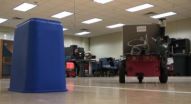(Press-News.org) Using deceptive behavioral patterns of squirrels and birds, researchers at the Georgia Institute of Technology have developed robots that are able to deceive each other. The research is funded by the Office of Naval Research and is led by Professor Ronald Arkin, who suggests the applications could be implemented by the military in the future. The research is highlighted in the November/December 2012 edition of IEEE Intelligent Systems.
Arkin and his team learned by reviewing biological research results that squirrels gather acorns and store them in specific locations. The animal then patrols the hidden caches, routinely going back and forth to check on them. When another squirrel shows up, hoping to raid the hiding spots, the hoarding squirrel changes its behavior. Instead of checking on the true locations, it visits empty cache sites, trying to deceive the predator.
Arkin and his Ph.D. student Jaeeun Shim implemented the same strategy into a robotic model and demonstration. The deceptive behaviors worked. The deceiving robot lured the "predator" robot to the false locations, delaying the discovery of the protected resources.
"This application could be used by robots guarding ammunition or supplies on the battlefield," said Arkin, a Regents Professor in Georgia Tech's School of Interactive Computing. "If an enemy were present, the robot could change its patrolling strategies to deceive humans or another intelligent machine, buying time until reinforcements are able to arrive."
Click here to see a lab video of the demonstration.
Arkin and his student Justin Davis have also created a simulation and demo based on birds that might bluff their way to safety. In Israel, Arabian babblers in danger of being attacked will sometimes join other birds and harass their predator. This mobbing process causes such a commotion that the predator will eventually give up the attack and leave.
Arkin's team investigated whether a simulated babbler is more likely to survive if it fakes or feigns strength when it doesn't exist. The team's simulations, based on biological models of dishonesty and the handicap principle, show that deception is the best strategy when the addition of deceitful agents pushes the size of the group to the minimum level required to frustrate the predator enough for it to flee. He says the reward for deceit in a few of the agents sometimes outweighs the risk of being caught.
"In military operations, a robot that is threatened might feign the ability to combat adversaries without actually being able to effectively protect itself," said Arkin. "Being honest about the robot's abilities risks capture or destruction. Deception, if used at the right time in the right way, could possibly eliminate or minimize the threat."
From the Trojan Horse to D-Day, deception has always played a role during wartime. In fact, there is an entire Army field manual on its use and value in the battlefield. But Arkin is the first to admit that there are serious ethical questions regarding robot deception behavior with humans.
"When these research ideas and results leak outside the military domain, significant ethical concerns can arise," said Arkin. "We strongly encourage further discussion regarding the pursuit and application of research on deception for robots and intelligent machines."
This isn't the first time Arkin has worked in this field. In 2010, he and Georgia Tech Research Institute Research Engineer Alan Wagner studied how robots could use deceptive behavior to hide from humans or other intelligent machines.
INFORMATION:
Squirrels and birds inspire researchers to create deceptive robots
2012-12-03
ELSE PRESS RELEASES FROM THIS DATE:
College students report low flu vaccine rate
2012-12-03
WINSTON-SALEM, N.C. – Dec. 3, 2012 – College football and basketball games may provide more than a way for students to show school spirit – they could help prevent the flu.
According to a new study by researchers at Wake Forest Baptist Medical Center, colleges and universities should implement new or improved influenza vaccine strategies, such as giving flu shots at sporting events or during campus-wide, day-long campaigns, to increase the number of their students who get the annual flu vaccine.
In the early online edition of the December issue of the Journal of American ...
PET imaging used to more accurately manage treatment, predict survival for patients with gliomas
2012-12-03
Reston, Va. (December 3, 2012) – In the management of gliomas—or tumors that originate in the brain—precise assessment of tumor grade and the proliferative activity of cells plays a major role in determining the most appropriate treatment and predicting overall survival. Research published in the December issue of The Journal of Nuclear Medicine (JNM) highlights the potential of imaging with 3'-deoxy-3'-F-18-fluorothymidine (F-18-FLT) positron emission tomography (PET) to noninvasively and accurately provide tumor-specific details to guide management of patients with gliomas.
Gliomas ...
Iron deficiency and cognitive development: New insights from piglets
2012-12-03
University of Illinois researchers have developed a model that uses neonatal piglets for studying infant brain development and its effect on learning and memory. To determine if the model is nutrient-sensitive, they have done some research on the effects of iron-deficient diets.
"Iron deficiency is a major problem worldwide," said Rodney Johnson, professor of animal sciences and director of the Division of Nutritional Sciences. "Infants who experience iron deficiency during the first 6 to 12 months of age can have irreversible developmental delays in cognition."
He ...
Dressing US troops to safeguard against insect attacks
2012-12-03
This press release is available in Spanish.Outfitting soldiers with clothing that effectively repels or kills insects is one of the strategies U.S. Department of Agriculture (USDA) scientists are using to help protect U.S. military personnel deployed overseas against disease-transmitting mosquitoes and sand flies.
As part of the Deployed War-Fighter Protection Research Program, scientists at the Agricultural Research Service (ARS) Center for Medical, Agricultural, and Veterinary Entomology (CMAVE) in Gainesville, Fla., and other ARS laboratories are collaborating with ...
U-M study shows BPA exposure in fetal livers
2012-12-03
ANN ARBOR—New research from the University of Michigan School of Public Health found BPA, or bisphenol A, in fetal liver tissue, demonstrating that there is considerable exposure to the chemical during pregnancy.
Researchers also found a proportionately higher concentration of free BPA—as opposed to the conjugated forms modified by the body for elimination—further showing that in fetuses the ability to eliminate the chemical from the body is not the same as in adults.
"The general message from our research is that people have to be cognizant of the fact that the adult ...
Kansas State University research shows iron's importance in infection, suggests new therapies
2012-12-03
MANHATTAN, KAN. -- A Kansas State University research team has resolved a 40-year-old debate on the role of iron acquisition in bacterial invasion of animal tissues.
The collaborative research -- led by Phillip Klebba, professor and head of the department of biochemistry -- clarifies how microorganisms colonize animal hosts and how scientists may block them from doing so. The findings suggest new approaches against bacterial disease and new strategies for antibiotic development.
The study -- in collaboration with Tyrrell Conway, director of the Microarray and Bioinformatics ...
Steps towards filming atoms dancing
2012-12-03
This press release is available in Spanish.
With their ultra short X-ray flashes, free-electron lasers offer the opportunity to film atoms in motion in complicated molecules and in the course of chemical reactions. However, for monitoring this motion, the arrival time and the temporal profile of the pulses which periodically illuminate the system, must be precisely known. An international team of scientists has now developed a measurement technique that provides complete temporal characterization of individual FEL (free-electron laser) pulses at DESY's soft-X-ray ...
Gender and race: How overlapping stereotypes affect our personal and professional decisions
2012-12-03
NEW YORK -- December 3, 2012 -- Racial and gender stereotypes have profound consequences in almost every sector of public life, from job interviews and housing to police stops and prison terms. However, only a few studies have examined whether these different categories overlap in their stereotypes. A new study on the connections between race and gender – a phenomenon called gendered race – reveals unexpected ways in which stereotypes affect our personal and professional decisions.
Within the United States, Asians as an ethnic group are perceived as more feminine in comparison ...
How 'transparent' is graphene?
2012-12-03
CAMBRIDGE, Mass. -- The amazing electrical, optical and strength properties of graphene, a single-atom-thick layer of carbon, have been extensively researched over the last decade. Recently, the material has been studied as a coating that might confer electrical conductivity while maintaining other properties of the underlying material.
But the "transparency" of such a graphene coating to wetting — a measure of the degree to which liquids spread out or bead up on a surface — is not as absolute as some researchers had thought. New research at MIT shows that for materials ...
Record high for global carbon emissions
2012-12-03
UEA research shows record high for global carbon emissions
Global carbon dioxide (CO2) emissions are set to rise again in 2012, reaching a record high of 35.6 billion tonnes - according to new figures from the Global Carbon Project, co-led by researchers from the Tyndall Centre for Climate Change Research at the University of East Anglia (UEA).
The 2.6 per cent rise projected for 2012 means global emissions from burning fossil fuel are 58 per cent above 1990 levels, the baseline year for the Kyoto Protocol.
This latest analysis by the Global Carbon Project is published ...

